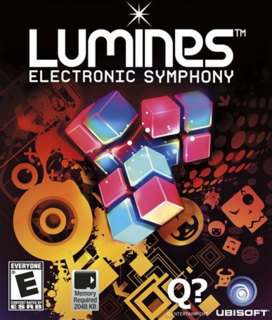A worthwhile addition to the series, but a couple lacking features prevents it from truly shining.
Lumines: Electronic Symphony, however, is beginning to lose a little of its luster. The core gameplay has rarely evolved over the seven years that this franchise has been out, and this particular installment is missing features the previous two games had. There are no puzzle modes to be found and you cannot challenge the computer to a versus mode. You can play versus via ad hoc, but unfortunately there is no online component. Since the Vita is being marketed heavily for its online features, a puzzle game without an online versus mode is a serious oversight.
The main mode called Voyage takes you on a journey through over 30 different skins (levels) that feature licensed and original music. Every time you move a piece around, place a block on the playing field and clear blocks, sound effects chime in to the beat and tune of the music. When you're lost in the game, the feeling you get is akin to being in a trance. As you continue to clear levels, you also unlock the skins where you can pick and chose what levels you would like to play in Playlist mode. You can either limit yourself to just the stages you pick, or you can play on an infinite loop.
There's a time attack mode called Stopwatch where you try to amass as many points as you can in 30, 60, 180 and 300 second intervals. There's also a mode called Master, which varies in different degrees of difficulty. In Master, the drop speed of your pieces is set pretty high, and you have to survive as long as you can to earn the best score you can get. There's also a feature called the World Block, which is a giant cube comprised of millions of squares. If you are connected online, the squares you clear in a 24 hour time period are subtracted from the World Block total, and if enough players from around the world manage to clear the World Block, every person who contributed for that time period gets bonus experience points. As you play, you earn experience points and unlock new skins and avatars.
If you never played a Lumines game before, the gameplay is quite simple. Your pieces are made out of four squares that form a block. They can be a mixture of either two different colors, or they can be all the same color. In order to clear squares, you have to join together at least four to start a group. You can attach extra squares to a group provided it manages to form a square or rectangle. There is a line that passes over the playing field called the Time Line, and any group it passes over is deleted. The more groups you delete at a time, the larger your score is.
One strategy that can help you create giant chains is to create a thin border of one color that separates another color and then wait for a Chain Block. This block will instantly turn any squares that touch each other of that specific color into a group. Then, once your Time Line passes over and it removes that group, the other two colors combine together and form one massive group. The Chain Block is an incredibly important tool to help you get out of trouble once your playing field becomes too high. There's also a new piece introduced to Electronic Symphony that's called the Shuffle Block, which shuffles all the colors of any square that's connected to each other. This can either be a major help or a sabotaging hindrance depending on your situation.
Another new addition to Electronic Symphony are avatar-specific power ups. Some avatars contain an ability to summon a Chain Block for the upcoming piece, while others let you summon Shuffle Blocks. Some will stop the Clear Line for a brief period, while others will give you more time before the next piece drops. Avatars also have Duel Abilities, which range from being beneficial to you to being detrimental to your opponent. The sad thing with these Duel Abilities is that you'll hardly ever use them since you can't play against the computer or play online.
Lumines was renowned for being a great showpiece title to show off the incredible for its time screen of the PSP, and Electronic Symphony fits its predecessor's shoes perfectly. The beautiful OLED screen of the Vita is constantly bombarded by pulsating lights and special effects that keep the background very busy. The blocks themselves change in design with the advance of every skin; it's an ever-changing cavalcade of colors.
Visuals aside, Lumines is also loved for its terrific music. Electronic Symphony contains music from such artists as the Chemical Brothers, Aphex Twin, LCD Soundsystem, Mark Ronson and the Business featuring Q-Tip and many more. Like the previous games, it also features original music. Both licensed and original tracks are mixed to brilliant use to provide a trance-like feeling that envelopes you entirely into the fast-paced puzzle gameplay. In conjunction with the amazing visuals, Electronic Symphony's presentation is top notch.
If you never played Lumines before, then it's a perfect pick up for your shiny new PS Vita. If you're a fan of Lumines games, then you may be disappointed in the lack of Vs. CPU and Puzzle modes. Voyage will continue to keep you addicted regardless, but the asking price is 40 dollars and that's a bit steep considering there's also no online mode. The game can also be played using the touchscreen, but it doesn't provide nearly the level of precision the d-pad does. Still, for puzzle fans, Electronic Symphony is still very much deserving to be included into any Vita owner's collection.

